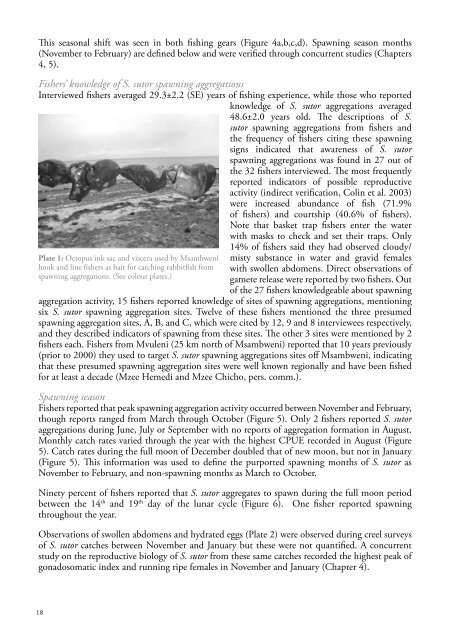WIOMSA-CORDIO spawning book Full Doc 10 oct 13.pdf
WIOMSA-CORDIO spawning book Full Doc 10 oct 13.pdf
WIOMSA-CORDIO spawning book Full Doc 10 oct 13.pdf
You also want an ePaper? Increase the reach of your titles
YUMPU automatically turns print PDFs into web optimized ePapers that Google loves.
This seasonal shift was seen in both fishing gears (Figure 4a,b,c,d). Spawning season months(November to February) are defined below and were verified through concurrent studies (Chapters4, 5).Fishers’ knowledge of S. sutor <strong>spawning</strong> aggregationsInterviewed fishers averaged 29.3±2.2 (SE) years of fishing experience, while those who reportedknowledge of S. sutor aggregations averaged48.6±2.0 years old. The descriptions of S.sutor <strong>spawning</strong> aggregations from fishers andthe frequency of fishers citing these <strong>spawning</strong>signs indicated that awareness of S. sutor<strong>spawning</strong> aggregations was found in 27 out ofthe 32 fishers interviewed. The most frequentlyreported indicators of possible reproductiveactivity (indirect verification, Colin et al. 2003)were increased abundance of fish (71.9%of fishers) and courtship (40.6% of fishers).Note that basket trap fishers enter the waterwith masks to check and set their traps. OnlyPlate 1: Octopus ink sac and viscera used by Msambwenihook and line fishers as bait for catching rabbitfish from<strong>spawning</strong> aggregations. (See colour plates.)14% of fishers said they had observed cloudy/misty substance in water and gravid femaleswith swollen abdomens. Direct observations ofgamete release were reported by two fishers. Outof the 27 fishers knowledgeable about <strong>spawning</strong>aggregation activity, 15 fishers reported knowledge of sites of <strong>spawning</strong> aggregations, mentioningsix S. sutor <strong>spawning</strong> aggregation sites. Twelve of these fishers mentioned the three presumed<strong>spawning</strong> aggregation sites, A, B, and C, which were cited by 12, 9 and 8 interviewees respectively,and they described indicators of <strong>spawning</strong> from these sites. The other 3 sites were mentioned by 2fishers each. Fishers from Mvuleni (25 km north of Msambweni) reported that <strong>10</strong> years previously(prior to 2000) they used to target S. sutor <strong>spawning</strong> aggregations sites off Msambweni, indicatingthat these presumed <strong>spawning</strong> aggregation sites were well known regionally and have been fishedfor at least a decade (Mzee Hemedi and Mzee Chicho, pers. comm.).Spawning seasonFishers reported that peak <strong>spawning</strong> aggregation activity occurred between November and February,though reports ranged from March through October (Figure 5). Only 2 fishers reported S. sutoraggregations during June, July or September with no reports of aggregation formation in August.Monthly catch rates varied through the year with the highest CPUE recorded in August (Figure5). Catch rates during the full moon of December doubled that of new moon, but not in January(Figure 5). This information was used to define the purported <strong>spawning</strong> months of S. sutor asNovember to February, and non-<strong>spawning</strong> months as March to October.Ninety percent of fishers reported that S. sutor aggregates to spawn during the full moon periodbetween the 14 th and 19 th day of the lunar cycle (Figure 6). One fisher reported <strong>spawning</strong>throughout the year.Observations of swollen abdomens and hydrated eggs (Plate 2) were observed during creel surveysof S. sutor catches between November and January but these were not quantified. A concurrentstudy on the reproductive biology of S. sutor from these same catches recorded the highest peak ofgonadosomatic index and running ripe females in November and January (Chapter 4).18


















